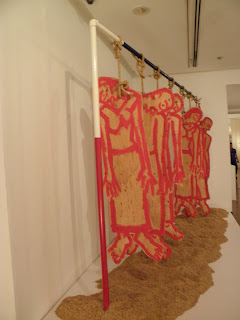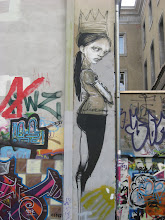"To you your religion and to me my religion."
-Islamic Proverb
I spend the morning roaming around Little India but when a tropical downpour rains from the heavens I make a dash underground and take the MRT to Chinatown.
I lose track of time as I wander under the swaying red lanterns perusing the merchandise; everything from pickled snakes to fake Rolex watches. I duck into a tailor shop and get caught caressing some of the finer silks. I inquire about having an item custom made but after a ten minute discussion the tailor decides he could not make it satisfactorily. I admire that.
At another shop I stop to search for coins to cast for I Ching but the rather insistent shop owner ends up selling me actual I Ching sticks. I suspect that, despite having bartered her down to half of her original offer, I've still paid too much when she hands me one of the coins I was looking at. "You take," she says. "Will bring you good luck and good fortune. Put in your wallet, it will attract money."
I wander into the Hindu temple and watch the last rites of a puja being performed before continuing to a mosque with a welcome sign. I take advantage of this, as this is the first time I have been allowed inside a mosque. The walls are lined with historical accounts of Islam as well as information about the Muslim faith. I pick up a pamphlet titled: Women in Islam: Beyond Stereotypes.
It outlines in great detail how equitable Islam has been to women in the past, from the 7th century to medieval times, permitting women to, among other things; reject arranged marriages, own property and get divorced. Under Social Roles it reads:
Muslims often express sympathy for women in the West, who often suffer from sexual exploitation and abuse at home and in the workplace, while being unappreciated in their traditional roles. Western women who seek to be respected must often dress and behave like men, are expected in practise to neglect their children's needs for the sake of their careers. In Islam, femininity is appreciated, and Muslim women may seek a higher education, work outside the home or volunteer as long as their primary responsibilities are taken care of.
I can't help but wonder who decides whether these "primary responsibilities" are being properly tended to. Still, as much as I hate to admit it, I can't actually dispute this assessment of Western culture. But then I can't think of a single culture on earth where someone, male or female, isn't being oppressed in some way.
The pamphlet concludes somewhat chastisingly:
For women who enjoy being women and appreciate the differences (as well as common ground) between sexes, who would prefer to be respected for their intelligence and character rather than being chased after for their looks, and would like to pursue personal and spiritual fulfilment without having to neglect their families, Islam is a very appealing alternative.
Personally, I would like all those things, without having to adhere to a laundry list of codes and regulations that determine what is and is not feminine and state that I don't deserve to be treated with respect if I don't happen to fit that mold. But that's me. Obviously I'm not signing up for any organized religion any time soon,
Islam or not.
Still, it does leave me wondering: If within group differences are greater than between group differences, when are we all going to stop trying to put each other in labeled boxes and get to the important matters of human affairs? Human affairs, mind you; not 'feminine" interests, not "manly" pursuits, not Muslim faith or Christian charity but simply "us" and "ours" because there is no "them".
I decide aliens are our only answer. Or zombies. I think the threat of some other "other" is the only hope we have of people finally accepting that, for all the infinitely unique ways there are to be human, ultimately, the only thing that matters is that we are.
On the corner of the street I duck into a traditional Chinese medicine pharmacy to see if they might have anything to treat my persistent eczema. I take a seat at a wooden table and watch the two pharmacists prepare orders, pulling intestinal looking plants out of jars from the display cases and dried herbs from paper bags stored in the small wooden drawers that line the walls behind them, like the card catalogs in the libraries of my youth. Nothing is labeled but they seem to know where to find precisely what they need amongst what must be thousands of herbs and plants. Occasionally they measure using a balance scale but mostly they rely on experience. This twiggy plant they chop with a knife, those pods they crush with a mortar and pestle; some they toss together in individual tea bags, others get wrapped separately in paper.
The shop itself reminds me of a soda shop circa 1950's Elvis movies, but with wooden, rather than chrome, display cases that hold curiously pickled animal parts rather than home made pies. It's spotlessly clean and bright and feels modern despite the lack of a single computer or machine of any kind. One pharmacist pauses in her work, then confers with the other. Unable to agree they pull out a giant scroll and unroll it across the counter top. Their fingers and eyes scan, in perfect unison, from top to bottom, top to bottom until, "Ahhh," they both laugh and nod. Perhaps neither was right.
I am almost sad when it's my turn, I would love to watch them a while more, but I ask if they might have something for my skin and show her my elbows.
"Ahhh, yes, no problem." She calls to the girl at the cash register who leaves her post and returns with a yellow box covered in Chinese characters and a sketch of what looks like either a nut or a brain. I open the box and pull out the glass bottle filled with a cherry red liquid.
"Do I drink it?" I ask worriedly.
"No, no. On skin. It's very effective," the pharmacist assures me.
I pay $10 SD for the bottle and after a week I am not disappointed. It smells vile but it works.
I stop at a food stall and order a fresh mango and passion fruit juice. It tastes even better than it looks, and it looks so good no less than four people stop to ask me what it is and where I got it.
I seek sanctuary in the auspicious Buddha temple, where I search through their expansive collection of artifacts to gaze upon the relics of Buddha's tooth (and nose, and brain, and heart and lungs). Afterward, I sit on the cool marbled floor of the balcony for nearly an hour listening to the chanting below fill the ornate temple and wishing it would never end.








